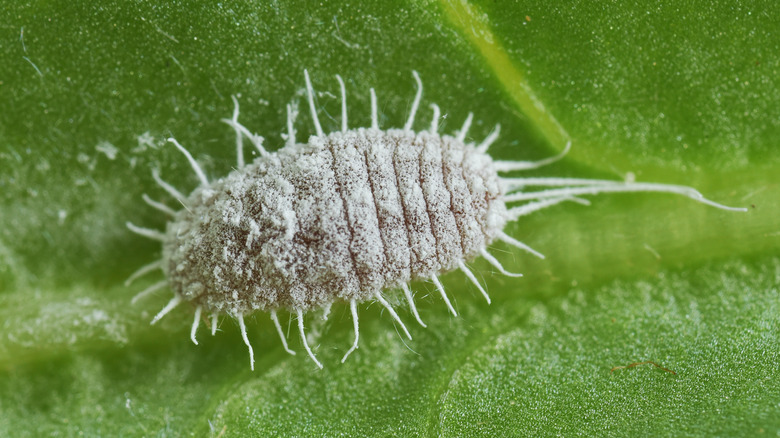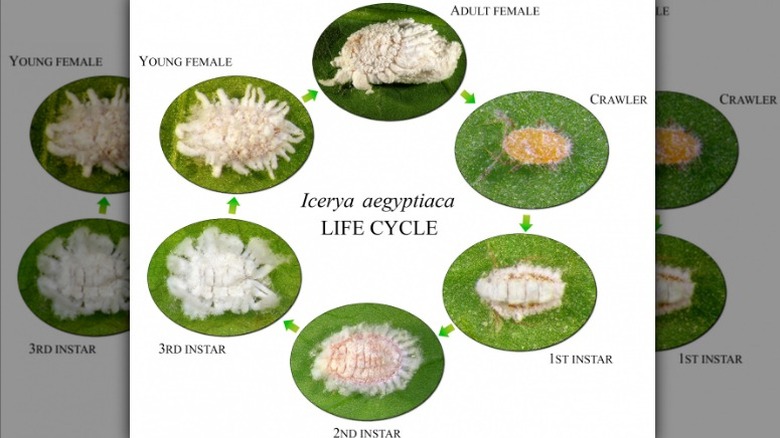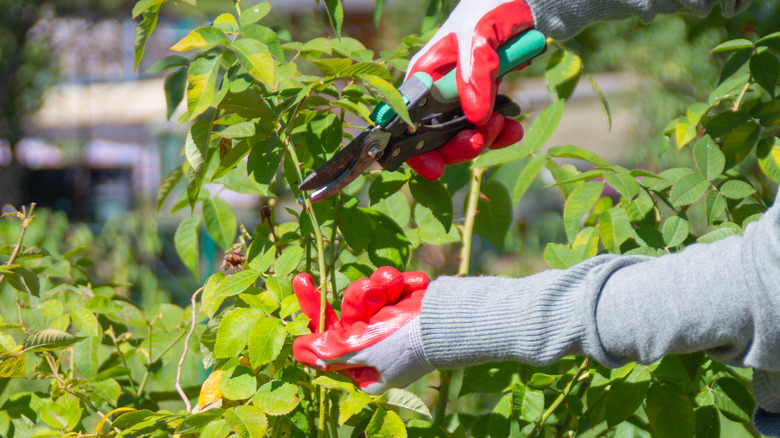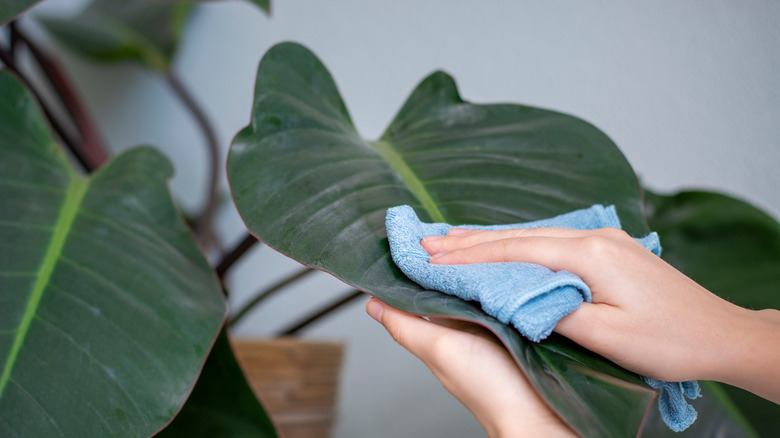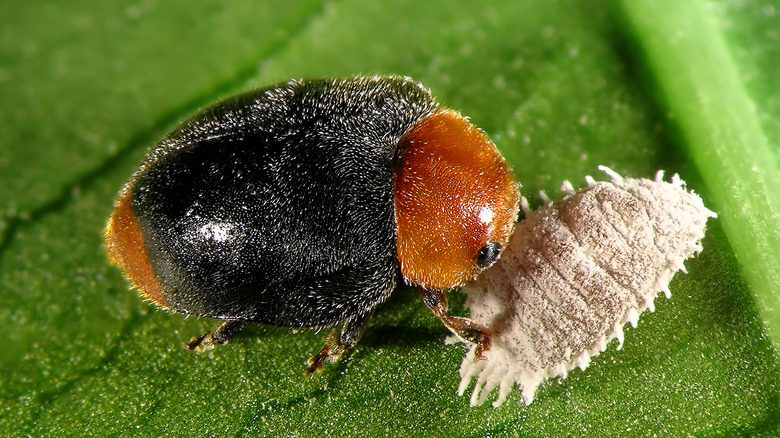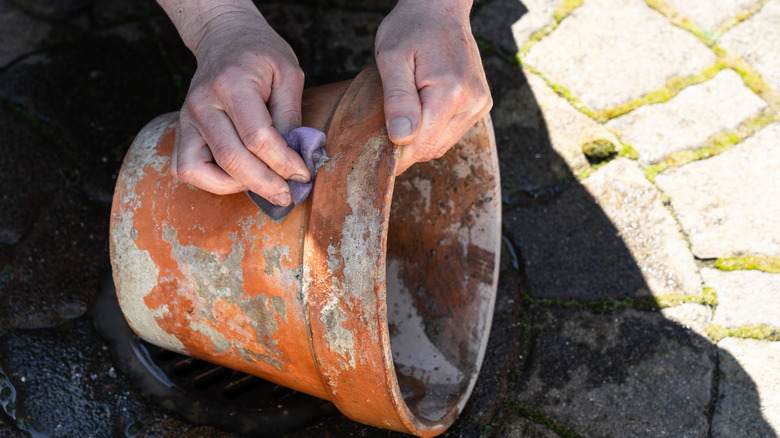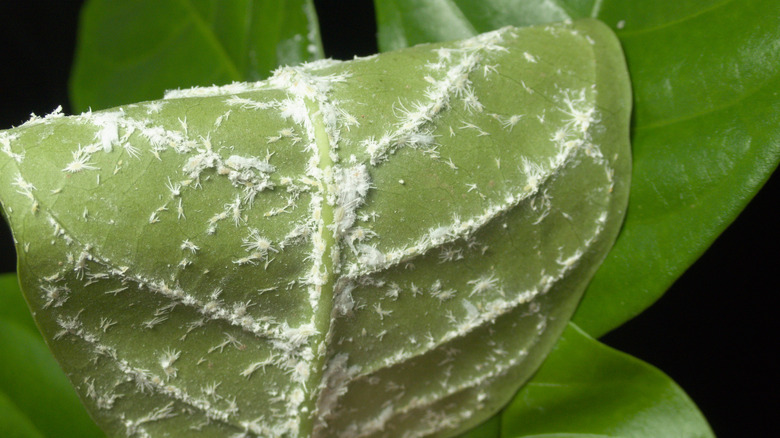How To Get Rid Of White Bugs On Plants
Have you ever come across a cluster of fuzzy white things on any of your plants? If you have, you probably thought, "What the heck is this?" and went on with your day. Chances are, your plant died a few weeks later. But now it's the second time you're coming across these bugs, and you're here to learn how to get rid of them.
Those measly-looking bugs are called mealybugs, and they are bad news for your garden. They feed off of the sap from your plants. As an effect, they cause deformities, stunted growth, yellow leaves, and in some cases, even death, according to Get Busy Gardening. How are you supposed to get your gardener bragging rights if they keep ruining all of your plants?
Not to worry — like always, we have got you covered. Below we'll run you through what causes mealybug infestations. We'll also give some tips on how to prevent and treat them to keep your garden healthy and thriving.
Where do mealybugs come from?
Mealybug infestation can have a few different causes. Mealybugs like warm climates and moisture, according to Green Matters. So having a freshly-watered plant sitting in the sun can be enough to attract the pests to your garden.
Ants can also cause mealybug infestations. Yes, ants. According to Get Busy Gardening, these insects are much wiser than we give them credit for. Ants can lead the mealybugs to your plant, and in return, they get to enjoy the honeydew that the bugs secrete. Communalism at its finest!
Sometimes, you can bring the bugs into your garden yourself. Bringing in potting soil that is infested with mealybugs is an easy way to start the spread. The rest of your plants could get infected through direct contact, shared tools, or even your hands. While we all love to add new plants to our collection, MSU recommends inspecting any plants before adding them to your garden.
Isolate and prune
If you have just noticed a mealybug infestation, chances it has been around for longer than you think. Unfortunately, these pesky bugs are usually present for at least four weeks before they become visible in clusters, says Plantophiles. Now, you have a long battle ahead.
The easiest and most effective way to stop a mealybug infestation is to get rid of the plant; however, many gardeners only want to do this as a last resort. If you have an emotional attachment to the plant, you can attempt to play doctor and save it. First, isolate the infected plant. By doing this, you are reducing the chances of having the infestation spread, says Leafy Place. Then, it's time to get the pruning shears and prune away the infested leaves and stems. According to Laid Back Gardener, every leaf should go. It is sad to see, but you are saving your plant from further damage.
Use liquid
If you want to try to save your plant without pruning off all of the leaves, there are a few steps you can take. First, take your plant to the sink and wash the leaves off. Planet Natural says that if your plant can withstand pressure, hose that baby off. The pressure will flush most of the white bugs away from your plant.
Next, dab a cotton swab in rubbing alcohol and clean your plant's leaves one after the other. It can be a tiresome process, but it'll all be worth it. After, mix a solution with 1 cup of rubbing alcohol, a couple of drops dish of soap, and a quart of filtered water. Then spray both sides of each leaf for the very best results. My City Plants writes that you should be sure to spray the entire plant, not just the places where the mealies are visible. You can repeat this process weekly as needed.
Bring in some assistance from mother nature
If you have a mealybug-infested garden or plant, you have a couple of options when it comes to procuring natural help. The first is going to your favorite garden store and purchasing black ladybugs, mealybugs' natural predators. The ladybugs are a sure way to keep those unwanted mealies out of your garden and to prevent an infestation from occurring in the first place, says Bob Villa.
Another option is applying neem oil. Since chemical-based insecticides can destroy your plants, neem oil is a safer alternative. According to Wally Grow, the oil is a natural insecticide that is safe for good bugs like honey bees while repelling or killing harmful ones. Talk about a two-in-one deal. All you have to do is to dilute the oil and spray it daily. You could also use the neem oil as a leaf shine solution as recommended by The Spruce.
Clean the pots
In getting rid of the white bugs for good, checking your plant's environment is important. If you've been facing repeated infestations, chances are, the bugs are laying eggs in your potting mix. This will cause an overlap of generations, and thus a consistent infestation, according to Get Busy Gardening. If the infested plant is potted, try repotting the plant to avoid fresh infestation.
Additionally, try looking at your tools and pots. While you may not want to use pesticides on your plant, you could always use them on your pots, plastics, and gardening equipment to keep bugs away, says Gardening Solutions.
Lastly, if you are working with an un-potted plant, you can always take off the topmost soil and replace it with a new potting mix. When you do this, make sure to clean the pot with some alcohol in the same method we recommended earlier, says Hobby Plants.
How to avoid infestation
Prevention is always much easier than a cure. Why go through the rigorous process of getting the mealybugs out when you can avoid having them in your garden in the first place?
Mealybugs are drawn to plants with high nitrogen content, say the experts at The Spruce. Avoid overwatering and overfertilizing your plants to prevent mealybugs from invading your garden.
Even without a plant infestation, wipe your plants in neem oil now and then. Planet Natural says that it has repellent properties and is effective in fighting off the white bugs and other similar pests. Like we said earlier, make a habit of hosing the less sensitive plants in your garden to shake off the new growth of mealy bugs.
Lastly, before taking your new plant home to obsess over, ensure that it is not infested. This is a critical part of plant shopping, says Apartment Therapy.
